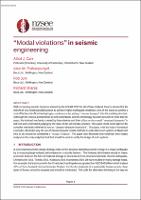| dc.contributor.author | Carr, Athol | |
| dc.contributor.author | J. Carr, Athol | |
| dc.contributor.author | Sharpe, Richard | |
| dc.contributor.author | Jury, Rob | |
| dc.date.accessioned | 2023-08-28T04:23:24Z | |
| dc.date.available | 2023-08-28T04:23:24Z | |
| dc.date.issued | 2023-04-19 | |
| dc.identifier.uri | https://repo.nzsee.org.nz/xmlui/handle/nzsee/2572 | |
| dc.description.abstract | With increasing seismic hazard as advised by the NSHM 2022 for entire New Zealand, there is a huge demand for the retrofit of existing building stock to achieve higher earthquake resilience. One of the ways to achieve a cost-effective retrofit achieving higher resilience is by adding “viscous dampers” into the existing structure. Although the viscous phenomenon is well understood, and the technology has been around for more than 50 years, the induced mechanics created by these devices and its effect on the overall “structural dynamics” is still not well understood by the state-of-the-art industry practice. This paper sheds light into this complex mechanics called here as “damper-structure-interaction”. The paper, with the help of numerical examples, also illustrates why it is flawed to use classical well established or popular modal methods to understand such system and why to do so should be considered a “modal crime”. The paper also illustrates that nonlinear time history analysis is the only analytical tool that should be used for the design of such systems. | |
| dc.language.iso | en | |
| dc.publisher | New Zealand Society for Earthquake Engineering | |
| dc.relation.ispartofseries | 2023;111 | |
| dc.subject | Advancements in research and practice in seismic performance | |
| dc.title | “Modal crimes” in structural engineering | |
| dc.type | Article | |

